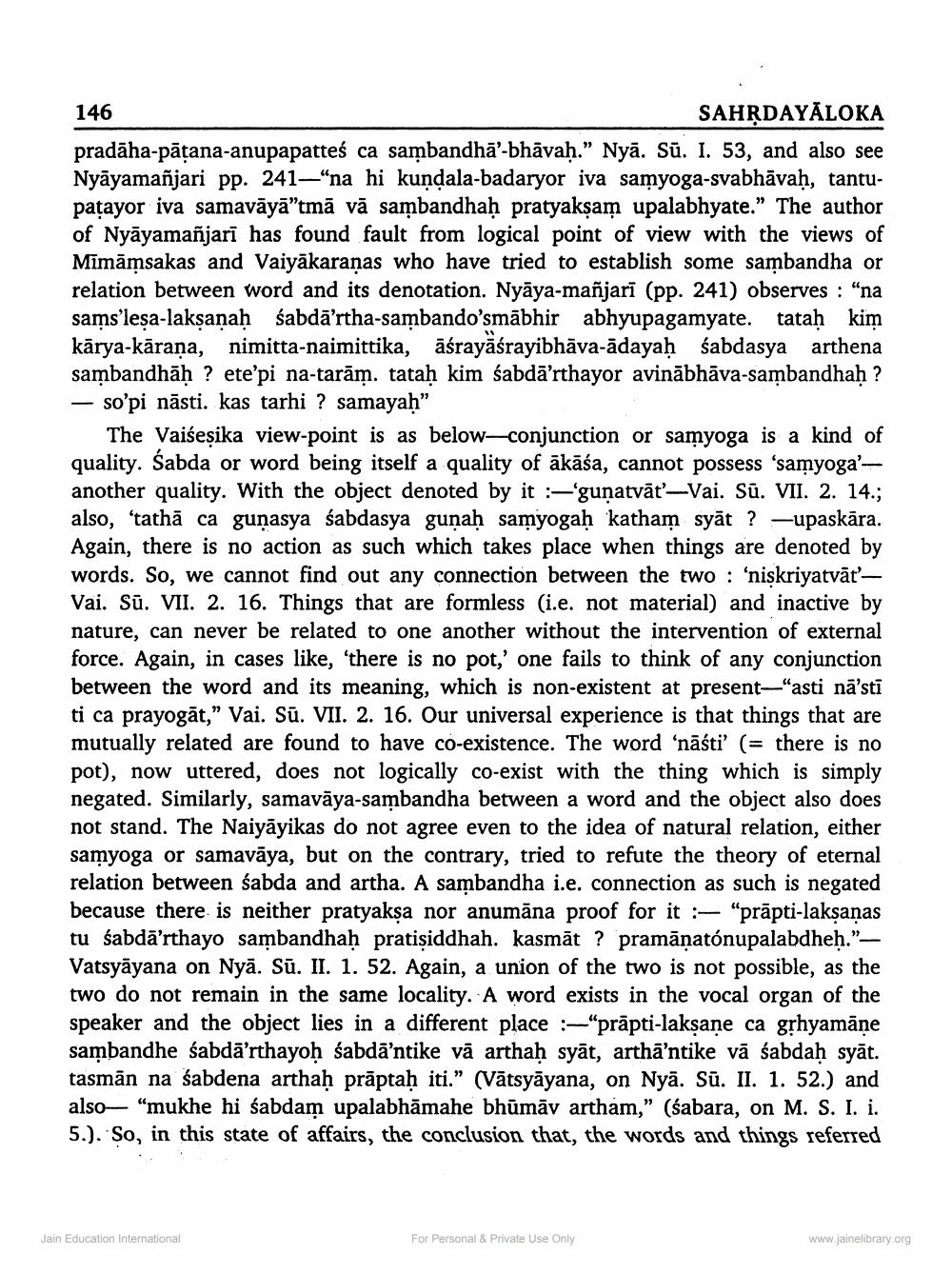________________
SAHṚDAYALOKA
pradāha-pāṭana-anupapatteś ca sambandhā'-bhāvaḥ." Nyā. Sū. I. 53, and also see Nyāyamañjari pp. 241-"na hi kundala-badaryor iva samyoga-svabhāvaḥ, tantupaṭayor iva samavāyā”tmā vā sambandhaḥ pratyakṣam upalabhyate." The author of Nyāyamañjarī has found fault from logical point of view with the views of Mīmāmsakas and Vaiyākaraṇas who have tried to establish some sambandha or relation between word and its denotation. Nyaya-mañjarī (pp. 241) observes: "na sams'lesa-lakṣaṇaḥ śabdā'rtha-sambando'smābhir abhyupagamyate. tataḥ kim kārya-kāraṇa, nimitta-naimittika, āśrayāśrayibhāva-ādayaḥ śabdasya arthena sambandhāḥ ? ete'pi na-tarām. tataḥ kim śabdā'rthayor avinābhāva-sambandhaḥ ? so'pi nāsti. kas tarhi ? samayaḥ"
146
The Vaiseṣika view-point is as below-conjunction or samyoga is a kind of quality. Śabda or word being itself a quality of ākāśa, cannot possess 'samyoga'another quality. With the object denoted by it :-'guṇatvāt'-Vai. Sū. VII. 2. 14.; also, 'tatha ca gunasya sabdasya gunaḥ samyogaḥ katham syat ? —upaskāra. Again, there is no action as such which takes place when things are denoted by words. So, we cannot find out any connection between the two: 'niskriyatvāť'— Vai. Sū. VII. 2. 16. Things that are formless (i.e. not material) and inactive by nature, can never be related to one another without the intervention of external force. Again, in cases like, 'there is no pot,' one fails to think of any conjunction between the word and its meaning, which is non-existent at present—“asti nā❜stī ti ca prayogāt," Vai. Sū. VII. 2. 16. Our universal experience is that things that are mutually related are found to have co-existence. The word 'nāśti' (= there is no pot), now uttered, does not logically co-exist with the thing which is simply negated. Similarly, samavāya-sambandha between a word and the object also does not stand. The Naiyāyikas do not agree even to the idea of natural relation, either samyoga or samavāya, but on the contrary, tried to refute the theory of eternal relation between sabda and artha. A sambandha i.e. connection as such is negated because there is neither pratyakṣa nor anumāna proof for it :-"prāpti-lakṣaṇas tu śabdā'rthayo sambandhaḥ pratiṣiddhah. kasmāt? pramāṇatónupalabdheḥ." Vatsyāyana on Nyā. Sū. II. 1. 52. Again, a union of the two is not possible, as the two do not remain in the same locality. A word exists in the vocal organ of the speaker and the object lies in a different place :-"prāpti-lakṣaṇe ca gṛhyamāņe sambandhe śabda'rthayoḥ śabda'ntike vā arthaḥ syāt, artha'ntike vā sabdaḥ syāt. tasmān na śabdena arthaḥ prāptaḥ iti." (Vātsyāyana, on Nyā. Sū. II. 1. 52.) and also "mukhe hi sabdam upalabhāmahe bhūmāv artham," (śabara, on M. S. I. i. 5.). So, in this state of affairs, the conclusion that, the words and things referred
Jain Education International
For Personal & Private Use Only
-
www.jainelibrary.org




